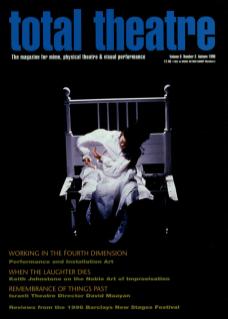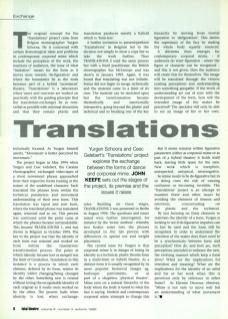The original concept for the Translations project came from Belgian mimeographer Yurgen Schoora. He is concerned with certain dramaturgical ideas and problems in contemporary corporeal mime which include the perception of the work, the reactions of audiences, the issue of what ‘imitation’ means for the form as it moves more towards 'de-figuration’ and where the boundaries lie as the work becomes part of a hybrid 'movement' theatre. Translations is a laboratory where issues and concerns are worked on practically with the guiding principle that the translation-exchanges be as non-verbal as possible with minimal discussion and that they remain plastic and technically focused. As Yurgen himself asserts, ‘Movement is better perceived by movement.’
The project began in May 1994 when Yurgen and Cesc Gelebert, the Catalan choreographer, exchanged video-tapes of a short movement phrase approached from their respective forms looking at the nature of the undefined character. Each translated the phrases from within the technical parameters and movement understanding of their own form. This translation was taped and sent back, where the translated phrase was translated again, returned and so on. This process was continued until the point came at which the phrases became untranslatable. This became Translations 1, and was shown in Belgium in October 1994. The key to the project was that the identity of each form was retained and worked on from within the translation/ transformation process. The point at which identity became lost or merged was the limit of translation. Translation in this instance is a process in which each element, defined by its form, retains its identity whilst changing / being changed by the other. Something new is created without losing the recognisable identity of each original as it works on / is worked on by the other. The process halts when identity is lost, when exchange translation produces merely a hybrid which is ‘form-less'.
A further invitation to present/perform Translations in Belgium led to the decision not simply to show a copy but to take the work further. Thus Translations 2 used the same process but with a third practitioner, the British choreographer Sue McLennan, and was shown in January 1995. Again, it was found that translating was not infinite. Forms did not begin to merge stylistically and the material came to a limit of its own. The material can be stretched open but the transformation became thematically and emotionally interpretive, going beyond the plastic and technical and so breaking one of the key rules. Building on these stages, Translations 3 was presented in Berlin in August 1996. The questions and issues raised were further interrogated, for instance by the 'twins' method – whereby two bodies enter into the phrases developed in the lab process with differences in spatial use and weight placement.
The central issue for Yurgen is that corporeal mime is in danger of losing its identity as a technical, plastic theatre form in a multiform or hybrid theatre. As a distinct form it is usually recognised by its more populist historical images – e.g., burlesque pantomime, or as part of a shapeless ‘physical theatre'. Mime rests on a natural hierarchy of the body where the body is tuned to what the face is saying. Modern and contemporary corporeal mime attempts to change this hierarchy by moving from frontal figuration to 'defiguration'. This denies the supremacy of the face by making the whole body equally nuanced.
A dilemma then emerges for contemporary corporeal mime: if audiences do want figuration – where the figure or character can be recognised – and this is not given, then the audience will create this for themselves. The image will be translated through the viewers existing perceptions and understanding into something graspable. If the levels of understanding are out of sync with the development of the form, how will the intended image of the maker be perceived? The spectator will only be able to see an image of his or her own.
But if mime remains within figurative parameters (either as corporeal mime or as part of a hybrid theatre) it holds itself back, leaving little space for the new. New work which is inexplicit, unexpected, untypical, interrogative.
So mime needs to be de-figurative but in so doing runs the risk of causing confusion or becoming invisible. The Translations project is an attempt to examine these and other issues by avoiding the elements of themes and emotions, concentrating on the plastic and the technical.
By just focusing on these elements to maintain the identity of a form, Yurgen is looking to see if de-figurative impulses can in fact be used and the form still be recognised. In order to understand the intention of the maker does there need to be a synchronicity between form and perception? How do, and how are, such perceptions amended to embrace the new, the evolving nuances which keep a form alive? What are the implications for intention and meaning? What are the implications for the identity of an artist and his or her work when this is perceived only by reference to other forms? As Étienne Decroux observes, ‘Mime is not only to move well but an understanding of what movement is.’

